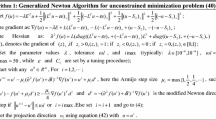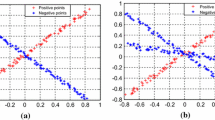Abstract
In this paper, we propose a novel feature selection method which can suppress the input features during the process of model construction automatically. The main idea is to obtain better performance and sparse solutions by introducing Tikhonov regularization terms and measuring the objective function with \(L_1 \)-norm, based on projection twin support vector machine. Furthermore, to make the problem easy to solve, the exterior penalty theory is adopted to convert the original problem into an unconstrained problem. In contrast with twin support vector machine which needs solve two QPPs, our method only solves two linear equations by using a fast generalized Newton algorithm. In order to improve performance, a recursive algorithm is proposed to generate multiple projection axes for each class. To disclose the feasibility and effectiveness of our method, we conduct some experiments on UCI and Binary Alpha-digits data sets.


Similar content being viewed by others
References
Bradley S, Mangasarian OL (2000) Massive data discrimination via linear support vector machines. Optim Methods Softw 13:1–10
Je HM, Kim D, Bang SY (2003) Human face detection in digital video using SVMEnsemble. Neural Process Lett 17(3):239–252
Joachims T (1998) Text categorization with support vector machines: learning with many relevant features, ECML-98. Springer, Berlin
Tang J, Li Z, Wang M et al (2015) Neighborhood discriminant hashing for large-scale image retrieval. IEEE Trans Image Process 24(9):2827–2840
Tang J, Shu X, Qi GJ et al (2016) Tri-clustered tensor completion for social-aware image tag refinement. IEEE Trans Pattern Anal Mach Intell. doi:10.1109/TPAMI.2016.2608882
Fung GM, Mangasarian OL (2005) Multicategory proximal support vector machine classifiers. Mach Learn 59(1–2):77–97
Mangasarian OL, Wild E (2006) Multisurface proximal support vector machine classification via generalized eigenvalues. IEEE Trans Pattern Anal Mach Intell 28(1):69–74
Khemchandani R, Jayadeva Chandra S (2007) Fuzzy twin support vector machines for pattern classification. IEEE Trans Pattern Anal Mach Intell 29(5):905–910
Xie X, Sun S (2014) Multi-view Laplacian twin support vector machines. Appl Intell 41(4):1059–1068
Xie X, Sun S (2015) Multi-view twin support vector machines. Intell Data Anal 19(4):701–712
Xie X, Sun S (2015) Multitask centroid twin support vector machines. Neurocomputing 149(PB):1085–1091
Ye Q, Zhao C, Ye N et al (2010) Multi-weight vector projection support vector machines. Pattern Recognit Lett 42(13):2006–2011
Chen X, Yang J, Ye Q et al (2011) Recursive projection twin support vector machine via within-class variance minimization. Pattern Recognit 44(s 10–11):2643–2655
Shao YH, Deng NY, Yang ZM (2012) Least squares recursive projection twin support vector machine for classification. Pattern Recognit 45(6):2299–2307
Ding S, Hua X (2014) Recursive least squares projection twin support vector machines for nonlinear classification. Neurocomputing 130:3–9
Zhang ML, Zhou ZH (2004) Improve multi-instance neural networks through feature selection. Neural Process Lett 19(1):1–10
Li Z, Liu J, Tang J et al (2015) Robust structured subspace learning for data representation. IEEE Trans Pattern Anal Mach Intell 37(10):1–1
Guo J, Yi P, Wang R et al (2014) Feature selection for least squares projection twin support vector machine. Neurocomputing 144(1):174–183
Tang J, Hong R, Yan S et al (2011) Image annotation by k NN-sparse graph-based label propagation over noisily tagged web images. ACM Trans Intell Syst Technol 2(2):135–136
Mangasarian OL (2006) Exact 1-norm support vector machines via unconstrained convex differentiable minimization. J Mach Learn Res 7(3):1517–1530
Gao S, Ye Q, Ye N (2011) 1-Norm least squares twin support vector machines. Neurocomputing 74(17):3590–3597
Ye Q, Zhao C, Ye N et al (2012) A feature selection method for nonparallel plane support vector machine classification. Optim Methods Softw 27(3):431–443
Yang ZM, He JY, Shao YH (2013) Feature selection based on linear twin support vector machines. Procedia Comput Sci 17:1039–1046
Fung G, Mangasarian OL (2004) A feature selection Newton method for support vector machine classification. Comput Optim Appl 28(2):185–202
Tikhonov Andrei N, Arsenin Vasiliy Y (1977) Solutions of Ill-posed Problems. Translated from the Russian, Preface by translation editor Fritz John, Scripta Series in Mathematics
Mangasarian OL (2002) A finite newton method for classification. Optim Methods Softw 17(17):913–929
Acknowledgements
This work was supported by the National Science Foundation of China (No. 61401214), the Project supported by the Jiangsu Key Laboratory of Image and Video Understanding for Social Safety (Nanjing University of Science and Technology), the Practice Innovation Training Program Projects for Jiangsu College Students (No. 201610298066Z), and the Top-notch Academic Programs Project of Jiangsu Higher Education Institutions (No. PPZY2015A062), and the Natural Science Foundation of Jiangsu Province (No. BK20140058).
Author information
Authors and Affiliations
Corresponding author
Rights and permissions
About this article
Cite this article
Yan, A.R., Ye, B.Q., Zhang, C.L. et al. A Feature Selection Method for Projection Twin Support Vector Machine. Neural Process Lett 47, 21–38 (2018). https://doi.org/10.1007/s11063-017-9624-4
Published:
Issue Date:
DOI: https://doi.org/10.1007/s11063-017-9624-4




